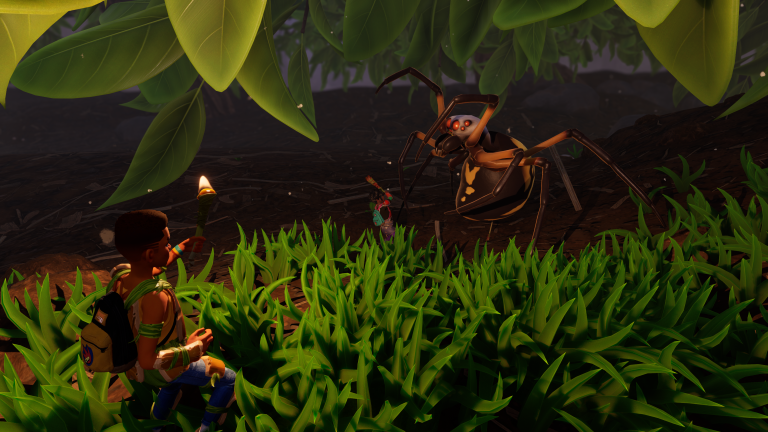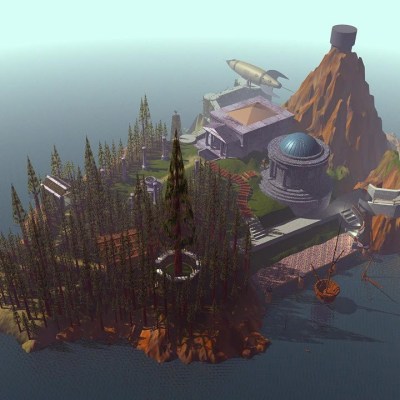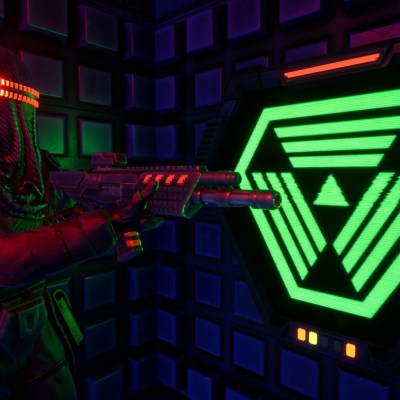How Obsidian’s Grounded Became a Different Kind of Survival Game
We talk to Obsidian and take a deep dive into the making of the studio's new survival game Grounded to see how it became such a big success.

Obsidian Entertainment’s Grounded has been on Steam Early Access and Xbox Game Preview for about a month now, turning heads on Steam in particular where it became a best-seller overnight. And the four-player cooperative survival/base-building game’s burgeoning community has spent the past weeks exploring the game’s uniquely bizarre world — a suburban backyard as viewed from the perspective of one of four shrunken-down teenagers.
The main goal is simple enough. Players have to work together to fight off all manner of hungry insects and arachnids, crafting armor and weapons, and building strange structures in and around the towering lunchboxes and misplaced electronics scattered about the forests of tree-sized blades of grass.
“There’s a pirate ship that someone made on the pond. I don’t even know how they did that,” says Grounded game director Adam Brennecke, who recently spoke to Den of Geek about the making of the game and its early-access launch. “I’m super impressed with all the players’ base building so far. I know that’s a cool part of the game, and that’s why we spent quite a bit of time adding a lot of features to the base building.”
Obsidian, maker of beloved RPGs like Fallout: New Vegas and Pillars of Eternity, is a relatively large studio, and it’s got several projects currently in development, like a new expansion for the excellent space adventure The Outer Worlds and an upcoming fantasy RPG Avowed. While each Obsidian project has its own dedicated team of developers, Grounded’s team is the smallest of them all.
“I think we have roughly 200 developers at Obsidian and the Grounded team is only about 13 to 14 people,” says Brennecke. “I’ve been at Obsidian for longer than 16 years now, and it’s definitely the smallest team I’ve ever been a part of, even going back to the early days working on Star Wars: Knights of the Old Republic II and Neverwinter Nights. But that doesn’t mean that we can’t get a lot of work done.”
You’d never know that Grounded was developed by such a tiny team, though. The game feels like a cohesive package, with harmonious gameplay loops and a distinctive visual style that looks nothing like anything else that’s currently on the market. Brennecke attributes the game’s level of polish to the team’s experience with the survival genre and, most importantly, long, long hours of playtesting.
“We’re a really small team, but we play the game a lot,” Brennecke explains. “We’ve played for hundreds of hours. And internally we are all super fans of the genre, so we’re continually discussing and adjusting and polishing the experience. And that was one thing that we really wanted to get right, making sure that the game just feels solid when you play it.”
Brennecke says the game evolved over time during the playtesting period, especially the intro section.
“I think this is our fifth or sixth version of the intro. We had one version where BURG.L, who’s your robot buddy, was actually talking to you right when you woke up. We’re trying to strike the balance of guiding the player but also having the player discover things on their own. And we’re still working on that. Even when we’re in Early Access and Game Preview, we still want to continue to improve the onboarding experience.”
A lot of the game’s cohesion comes from the familiarity of the setting. A suburban backyard should be familiar to just about everyone, so while the warped scale of the landscapes makes the game world wondrous to a certain extent, everything you see in the game should look immediately recognizable and of our world, which was important for the developers to get right.
“We set the game in the early nineties, and I think all that stuff kind of makes the game approachable and accessible, where the player kind of has a good understanding of what’s going on,” Brennecke says. “We’re all familiar with backyards, we’re all familiar with insects that you find in a backyard.”
The developers capitalized on the game design opportunities that the backyard setting presented in many ways that are as functional as they are aesthetically imaginative. “I think one thing that we learned making Fallout: New Vegas is having good landmark locations to get your bearings in an open world game,” Brennecke explains. “One thing that we did very purposefully is, we have the oak tree right in the smack-dab middle of the backyard. So that’s always something that you can kind of use to find your bearings. And it’s really, really fun whenever you discover a new manmade object and at the end of the day, it’s, like, a half-eaten hot dog, or a figurine, or a toy.”
While Grounded‘s backyard aesthetic is unlike the grittier and more hostile settings you might find in other popular survival games like DayZ, H1Z1, Conan Exiles, and Rust, that only makes Obsidian’s take more special. In making you traverse an everyday environment from a completely new perspective, Grounded delivers an experience you haven’t seen before in the genre.
“Another one of the goals of making the game was to have a huge grass forest and to have the player interact with all that grass in some way,” Brennecke says. “So the first thing we did was, like, okay, the player can cut down grass and build a fort out of it. And then we got the insect life moving around the grass and kind of working in this ecosystem outside the view of the player. And once we got that in, we were like, ‘Hey, a lot of the big insects are not moving around right.’ It was like a maze having them move around the grass. We were like, ‘Hey, wouldn’t it be amazing if the bigger creatures could actually displace the grass and actually just pass right through the grass blade? And then you get almost that Jurassic Park moment where you see the grass shaking in the distance and you’re like, ‘Oh, there’s something big over there.’”
Unlike the majority of survival games out there, Grounded is surprisingly accessible and relatively low-stress. You can die more than once and still recover your dropped loot, for example, and the scarcity of resources and materials is pretty forgiving and flexible to any playstyle. There is a measure of challenge to be found in the game to be sure in the form of imposing enemies and involved puzzles, but there’s also the sense that you have the freedom to play the game in a leisurely manner if you so choose.
“On the team, we’re all hardcore gamers and we like challenge, but we wanted to introduce it gradually,” Brennecke explains. “I think it kind of fits with the style of the game too, of just teenagers having fun in the backyard. We wanted to make it approachable and easy to kind of learn, especially for a survival game. If the player dies, for example, it’s not super punishing. Even if you’re new to the survival genre, it’s still a lot of fun. But for the hardcore audience, there’s a lot of meat and potatoes in the gameplay that they can sink their teeth into.”
Of all the challenges the team encountered in the developmental process, none were as unprecedented as the discovery that the game elicited extremely terrified responses in players with arachnophobia. There are large, semi-realistic looking spiders roaming around the environment at all times, and they’re virtually unavoidable if you want to play the game for any significant length of time, so the team had to come up with a solution that would allow people with a fear of spiders to play the game without suffering a panic attack.
“At an expo in London we had people play the game for the very first time,” Brennecke recalls.
“We could tell that a lot of people were just terrified. They just had to put their hands up and walk away. And when I was looking at that as the game director, I was like, ‘Hey, is there anything that we can do to help these people out?’ I’m okay with people being terrified. But at the point where they just have to, like, leave the room, that’s a little bit much.”
“So at the very same time, we started talking to the Microsoft User Research Lab,” Brennecke continues, “and we were getting them kind of integrated into the team and we were discussing the arachnophobia factor with them. They do a lot of playtesting and research into how to make our games better and all the different ways to interface stuff. And one thing that we brought up to them was arachnophobia. It was kind of a cool thing where a person named Blake Pellman was assigned to our team, and he did his doctorate in phobias. So he had actually already done a lot of research on that stuff.”
The team’s solution is the game’s “Arachnophobia Mode,” which is an option that allows players to change the way the in-game spiders are presented. There’s a slider that goes from 1 to 5, with the “1” setting displaying fully detailed spiders, and the “5” setting displaying what is essentially a couple of floating balls, with no spine-tingling spider legs to be seen. “It does look a little bit goofy,” Brennecke admits, “but we wanted to kind of just make a setting where those players could still play Grounded.”


